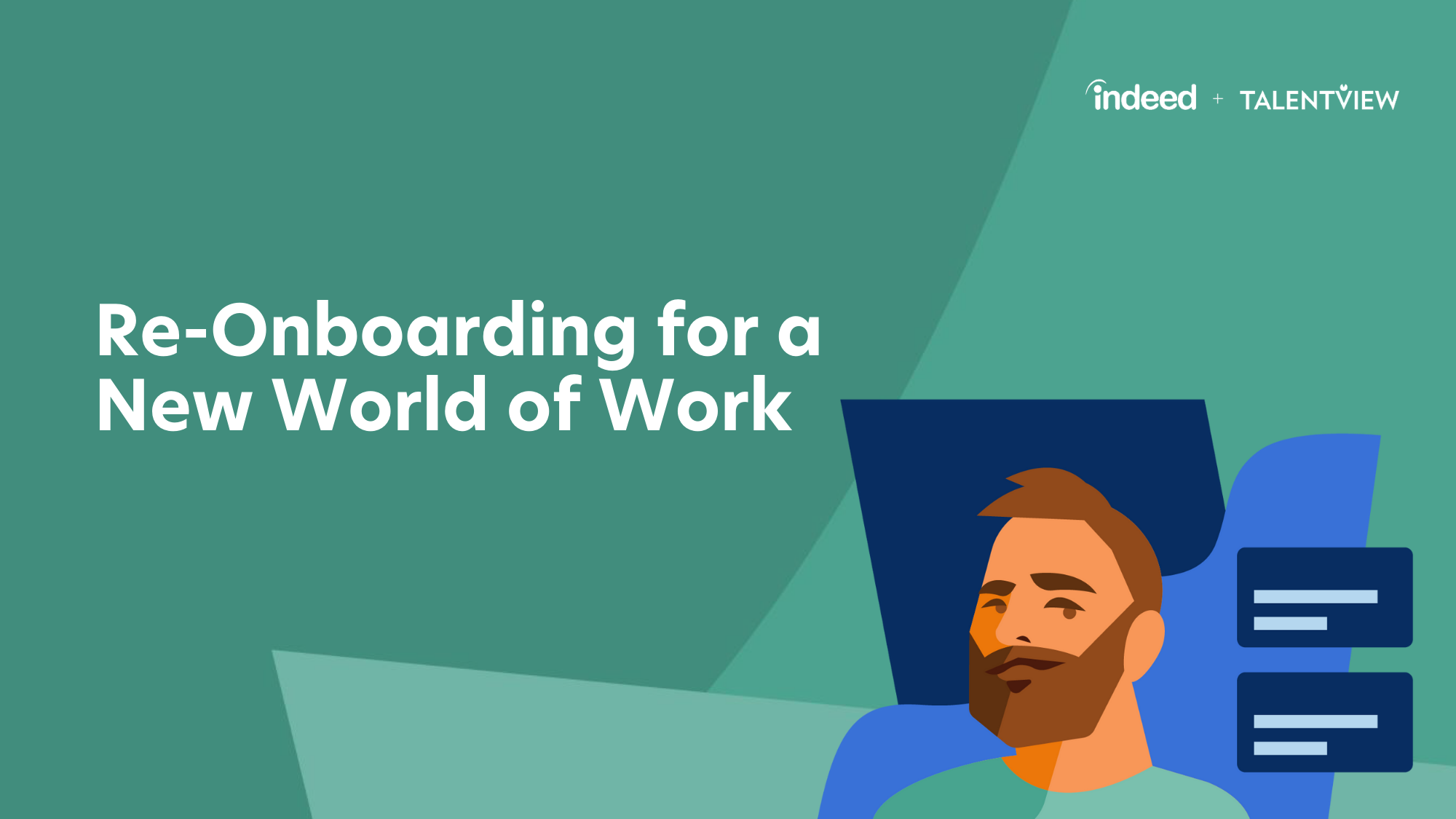Transforming Employee Experience for a for a New World of Work
The “normal” we have returned to could mean remote, hybrid, on-site, or some combination of these — while the workplace culture and employee experience have been transformed.
New remote and hybrid arrangements can greatly improve workplace safety and well-being, and human resources (HR) leaders can play a key role in helping your workforce adjust. Even for employees who never left, the sense of a fresh start can boost morale and provide clear guardrails moving forward. But how best to make this happen?
First, put good policies in place. Then convey them, train them and — why not support them with re-onboarding? Just as onboarding has become a vital part of the new hire’s journey, a re-onboarding phase can help you intentionally re-introduce workers and workplace culture after going through the crucible of COVID-19.
Here are five best practices to consider:
1. Offer compassionate support
It’s no question that employees have a greater need for flexibility and a different approach to scheduling. They may also worry that returning to the workplace is putting their health at risk.
Set clear, compassionate, and proactive policies that factor in the latest safety regulations and guidance and allow for tweaks when those are revised. However possible, open up flexibility, since the pressures of life and work have never been more integrated. Organizational values should be clearly communicated and reinforced to guide decision-making and behavior during this transition.
Of course, all of this won’t work unless your managers are up-to-date and on board. It often falls to them to convey, guide and make decisions on the fly, ensuring work gets done despite the challenges. Re-onboarding is an opportunity to formally provide them with the information, training and support they need to do their jobs. If they are confident they have the answers — or can get them — that will translate into confidence for their teams.
2. Create new processes and workflows
The pandemic has triggered a whole range of new behaviors and processes around how, when and where we work. In many cases, long-established workflows have shifted to become more practical and efficient. Employees need to understand the new processes and workflows, as well as new expectations about how they get their work done.
For example, as scattered, remote teams reassemble, we may see a preference for remaining on digital platforms rather than reverting to in-person communication. The fluidity and agility of modern project management software often provides greater visibility, democratized information access and a kind of neutral accountability across a given project’s lifecycle, shifting the focus from people to tasks. It also allows everyone to collaborate, no matter where they are.
A recent Gartner survey of HR leaders finds that 59% will let employees continue to work remotely on occasion, with managerial approval, so these tools are here to stay. It’s likely some employees struggled with new technology while others thrived; allocate re-onboarding time to training staff on platforms that bring everyone to the same level.
Re-onboarding is a powerful opportunity to formally incorporate process transformations that may have developed out of necessity into operations and culture. It also provides managers with a clearer roadmap on the skills and behaviors their workforces will need going forward.
3. Help boost well-being
Pre-pandemic, well-being programs were appearing, but were not necessarily the norm. Now we’ve seen how critical mental and emotional health is to engagement and performance in a very direct way.
Remote workforces came together as cohesive teams not just through hours logged, but also because they participated in holistic programs that boosted mind, body and spirit. Our appetite for programs that make us feel better has boomed, from virtually guided yoga, stretching, meditation, walks, runs and self-care. HR departments also found themselves building better support systems for employees with everything from coping strategies to one-on-one therapy.
I’ve always been a proponent of onboarding programs that offer support beyond the scope of day-to-day roles. Re-onboarding employees into a culture where their well-being is taken seriously is a tremendous gesture.
It also signals a shift in how management handles employee health issues, providing the opportunity to prove to employees that you care about their overall wellness. Trust and transparency go a long way toward alleviating anxiety over returning to work and making employees comfortable when they walk in the door.
4. Focus on communication
Before the pandemic, workplaces relied on four different kinds of communication: in-person verbal dialogue; body language and facial expressions; phone calls; and written form, such as emails, memos and notes.
We spent a tremendous amount of time and effort understanding the impact and best practices for each method. But the realities of how we work changed how we communicate, resorting to video meetings, chat and instant message, texts, and dedicated communication platforms. And what we communicated tended to focus on short-term questions like “How do we navigate?” and “Is everyone okay?”
Even if there isn’t a physical re-opening happening at your organization, this moment of transition is a key opportunity to unify a scattered workforce around a culture that’s undoubtedly gone through growing pains.
Evaluate what methods, platforms, and types of communication will help you succeed going forward, and get your whole company on message with a renewal of mission and purpose, showing them how communication supports your values.
5. Explain the new rules
Informing new hires of the policies and procedures around workplace safety have always been a priority during onboarding; ensuring existing employees know them as well has often been less structured, which may create some unintentional inconsistencies. And with COVID-19, a lapse in information could have serious consequences.
However, safety information isn’t exactly static: It must be able to be updated quickly to reflect the changing guidelines and protocols of governing bodies, while still fitting with your organization’s existing approach.
The most important information is around vaccines: who will require them, who would feel better if they knew their coworkers were vaccinated, and how the workplace can be configured to accommodate all.
Indeed research shows 63% of workers say COVID-19 vaccine access should be the biggest factor in determining when employers bring people back to the workplace. Meanwhile, the U.S. has reached a milestone, with 60% of its adults being vaccinated with at least one dose.
During re-onboarding, make it easy for employees to access detailed information on organizational policy with regards to vaccinations and other regulations. You should also offer information on employees’ rights in terms of their comfort level with returning to the workplace. If you have a policy for allowing health-compromised employees to work at home, make that known. But always be clear as to whether this information might change, and tell workers exactly where to look for updates.
Implementing a re-onboarding phase is both an effective way to establish new values, behaviors, policies and processes and reacclimate the workforce to your company culture. Ensure consistency between re-onboarding for existing employees and onboarding for new hires, so there’s no friction or questions. Level the playing field, celebrate the fact that people are coming back, and commit to increased transparency, information, and communication, wherever they are. It’s a powerful strategy for ensuring employees feel safe.
This article first appeared on Indeed website:
https://www.indeed.com/lead/reonboarding-for-a-new-world-of-work?hl=en&co=PH
TalentView is an official partner of Indeed in the APAC region.
DOWNLOAD INDEED
PRODUCT SHEET

Fill out the form below to learn how yo use Indeed to get your next hire.

TalentView is a leader in employer branding strategy, design and technology. With teams across the ASEAN region, TalentView’s professional solutions help to create memorable experiences across the talent lifecycle to attract, engage and retain talent. Working directly with business leaders in Fortune 1000 companies, TalentView is well-positioned to provide talent insights and is an accredited partner of key global players including Workplace from Meta, Talegent, Indeed, SeeMeCV, Hootsuite, Digimind and PhoenixATS.
Copyright © TalentView Asia, 2022 | Privacy Policy

















